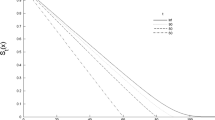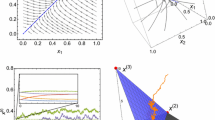Abstract
A population is considered stationary if the growth rate is zero and the age structure is constant. It thus follows that a population is considered non-stationary if either its growth rate is nonzero and/or its age structure is non-constant. We propose three properties that are related to the stationary population identity (SPI) of population biology by connecting it with stationary populations and non-stationary populations which are approaching stationarity. One of these important properties is that SPI can be applied to partition a population into stationary and non-stationary components. These properties provide deeper insights into cohort formation in real-world populations and the length of the duration for which stationary and non-stationary conditions hold. The new concepts are based on the time gap between the occurrence of stationary and non-stationary populations within the SPI framework that we refer to as Oscillatory SPI and the Amplitude of SPI.



Similar content being viewed by others
References
Anonymous (2014) A global brief on vector-borne diseases. World Health Organization, Geneva
Berkeley Human Mortality Database. http://www.mortality.org/
Bongaarts J, Bulatao RA (1999) Completing the demographic transition. Popul Dev Rev 25:515–29
Boulanouar M (2001) A mathematical study in the theory of dynamic population. J Math Anal Appl 255(1):230–259
Brouard N (1986) Structure et dynamique des populations La puramide des annees a vivre, aspects nationaux et examples regionaux, vol 4, pp 157–168
Brouard N (1989) Mouvements et modeles de population. Institut de formation et de recherches démographiques, Paris
Carey JR (2019) Aging in the wild, residual demography and discovery of a stationary population identity. In: Sears R, Lee R, Burger O (eds) Human evolutionary demography. Open Book Publishers, Cambridge
Carey JR, Papadopoulos N, Müller H-G, Katsoyannos B, Kouloussis N, Wang J-L, Wachter K, Yu W, Liedo P (2008) Age structure changes and extraordinary lifespan in wild medfly populations. Aging Cell 7:426–437
Carey JR, Müller HG, Wang JL, Papadopoulos NT, Diamantidis A, Koulousis Nikos A (2012a) Graphical and demographic synopsis of the captive cohort method for estimating population age structure in the wild. Exp Gerontol 47(10):787–791
Carey JR, Papadopoulos NT, Papanastasiou S, Diamanditis A, Nakas CT (2012b) Estimating changes in mean population age using the death distributions of live-captured medflies. Ecol Entomol 37:359–369
Carey JR, Silverman S, Rao ASRS (2018) The life table population identity: discovery, formulations, proofs, extensions and applications. In: Rao ASRS, Rao CR (eds) Handbook of statistics: integrated population biology and modelling, part A, vol 39. Elsevier, Amsterdam, pp 155–185
Cohen JE (1995) How many people can the earth support?. W.W. Norton & Company, New York
Cook PE, Hugo LE, Iturbe-Ormaetxe I, Williams CR, Chenoweth SF, Ritchie SA, Ryan PA, Kay BH, Blows MW, O’Neil SL (2006) The use of transcriptional profiles to predict adult mosquito age under field conditions. Proc Natl Acad Sci 103:18060–18065
Cook PE, McMeniman CJ, O’Neil SL (2008) Modifying insect population age structure to control vector-borne disease. Adv Exp Med Biol 627:126–140
Davis SW (2005) Topology, International edn. McGraw-Hill, Singapore
Detinova TS (1968) Age structure of insect populations of medical importance. Ann Rev Entomol 13:427–450
Gerade BB, Lee SH, Scott TW, Edman JD, Harrington LC, Kitthawee S, Jones JW, Clark JM (2004) Field validation of Aedes aegypti (Diptera: Culicidea) age estimation by analysis of cuticular hydrocarbons. J Med Entomol 41:231–238
Kelley JL (1975) General topology. Graduate texts in mathematics. Springer, Berlin
Keyfitz N (1971) On the momentum of population growth. Demography 8:71–80
Kim YJ, Schoen R, Sarma PS (1991) Momentum and the growth-free segment of a population. Demography 28:159–173
Lebowitz JL, Rubinow SI (1974) A theory for the age and generation time distribution of a microbial population. J Math Biol 1:17–36
Molleman F, Zwaan BJ, Brakefield PM, Carey JR (2007) Extraordinary long life spans in fruit-feeding butterflies can provide window on evolution of life span and aging. Exp Gerontol 42:472–482
Müller HG, Wang J-L, Carey JR, Caswell - Chen EP, Chen C, Papadopoulos N, Yao F (2004) Demographic window to aging in the wild: constructing life tables and estimating survival functions from marked individuals of unknown age. Aging Cell 3:125–131
Papadopoulos N, Carey JR, Ioannou C, Ji H, Müller H-G, Wang J-L, Luckhart S, Lewis E (2016) Seasonality of post-capture longevity in a medically-important mosquito (Culex pipiens). Front Ecol Evolut 4:63. https://doi.org/10.3389/fevo.20016.00063
Perthame B (2007) Transport equations in biology. Frontiers in Mathematics, Birkhäuser
Preston SH, Heuveline P, Guillot M (2001) Demography: measuring and modeling population processes. Blackwell Publishers, Malden
Rao ASRS (2014) Population stability and momentum. Not Am Math Soc 61(9):1062–1065
Rao ASRS, Carey JR (2015) Carey’s equality and a theorem on stationary population. J Math Biol 71:583–594
Rao ASRS, Carey JR (2019) Behavior of stationary population identity in two-dimensions: age and proportion of population truncated in follow-up. In: Rao ASRS, Rao CR (eds) Handbook of statistics: integrated population biology and modelling, part B. Elsevier, Amsterdam, pp 487–500
Rotenberg M (1983) Transport theory for growing cell populations. J Theor Biol 103(2):181–199
Ryder NB (1973) Two cheers for ZPG. Daedalus 102:45–62
Schoen R, Jonsson SH (2003) Modeling momentum in gradual demographic transitions. Demography 40:621–635
Vaupel JW (2009) Life lived and left: Carey’s equality. Demogr Res 20:7–10
Acknowledgements
We thank three referees for their critical review of the concepts introduced and for their several useful structural comments which helped us to thoroughly revise our original submission. Research supported in part through the UC Berkeley CEDA Grant P30AG0128 to JRC.
Author information
Authors and Affiliations
Corresponding author
Additional information
Publisher's Note
Springer Nature remains neutral with regard to jurisdictional claims in published maps and institutional affiliations.
Appendix
Appendix
Let,
and let \(\dot{I}\) and \(\dot{J}\) be the partitions of I and J, which are written as,
and
where \(I_{M}(t_{1})=[t_{0},t_{1}),\)\(I_{M}(t_{i})=[\delta _{i},t_{i+1})\) for \(i=2,\dots ,k\) and \(J_{N}(t_{i})=[t_{i},\delta _{i})\) for \(i=1,2,\dots ,k.\) Since \(I_{M}(t_{i})\) and \(J_{N}(t_{i})\) are non-degenerate intervals, the lengths of \(I_{M}(t_{i})\) and \(J_{N}(t_{i})\) are always positive. Hence, \(\text {max}I_{M}(t_{i})\), \(\min I_{M}(t_{i})\), \(\max J_{N}(t_{i})\), and \(\min J_{N}(t_{i})\) exist. Let \(f(a,t_{i})\) be the function specifying the proportion of individuals at age \(a\in A\) during \(I_{M}(t_{i})\) for \(f(a,t_{i}):I_{M}(t_{i})\rightarrow \mathbb {R}^{+}\) and A be the set of all ages in the population. Since SPI holds in \(I_{M}(t_{i})\), we have
where \(g(a,t_{i})\) is the function specifying remaining LR at age a during \(I_{M}(t_{i}).\)
Lemma 9
Suppose \(\triangle f(a,t_{i})=\hat{f}(a,t_{i})-\check{f}(a,t_{i})\) for \(i=1,2,3,\ldots ,k\), where \(\hat{f}(a,t_{i})=\max _{a}f(a,t_{i})\) and \(\check{f}(a,t_{i})=\min _{a}f(a,t_{i})\), then \(\triangle f(a,t_{i})\) is bounded for each \(I_{M}(t_{i}).\)
Proof
If there are at least two age groups in A, then \(\hat{f}(a,t_{i})\) and \(\check{f}(a,t_{i})\) exists within \(I_{M}(t_{i})\) and they are distinct. Suppose there are only two age groups in A, then (15) guarantees that there exist \(\hat{g}(a,t_{i})\) and \(\check{g}(a,t_{i})\) for \(\hat{g}(a,t_{i})=\max _{a}g(a,t_{i})\) and \(\check{g}(a,t_{i})=\min _{a}g(a,t_{i})\). This implies, \(\triangle f(a,t_{i})<\hat{g}(a,t_{i})+\check{g}(a,t_{i}).\) This inequality follows even if there are more than two age groups in A, and hence, \(\triangle f(a,t_{i})\) is bounded. \(\square \)
Theorem 10
\(\frac{1}{\Sigma \triangle f(a,t_{i})}\) is bounded on \(\left[ t_{0},t_{k+1}\right) .\)
Proof
Since \(\triangle f(a,t_{i})>0\) and \(\triangle f(a,t_{i})\) are bounded on \(I_{M}(t_{i})\) by Lemma (9), the result follows. \(\square \)
Suppose \(\hat{f}(a,t_{i})\) is concentrated around mean age of the population and \(\check{f}(a,t_{i})\) is concentrated around the very old age of the population, then \(\triangle f(a,t_{i})\) is an increasing function indicates one or more of the following three situations; i) longevity of the population is increasing without much change in the mean age, ii) mean age is reducing without reducing in longevity, and iii) mean age is reducing and simultaneously longevity is increasing.
Theorem 11
Suppose the partitions \(\dot{I}\) and \(\dot{J}\) are given, then \(1+\frac{k^{2}}{\hat{f}(a,t_{i})+\check{f}(a,t_{i})}>k\left( \frac{1}{\hat{f}(a,t_{i})}+\frac{1}{\check{f}(a,t_{i})}\right) \).
Proof
Consider the expression
Since \(\sum _{i=1}^{\infty }\int _{0}^{\infty }f(a,t_{i})da=k\) and both the terms of the expression (16) are negative, (16) can be written as
Simplifying (17), we will obtain the desired result. \(\square \)
Remark 12
For each \(t_{i}\) for \(i=1,2,\dots ,k\), without taking the summations in (16), we have
and
Let \(\varphi (a,t_{i})\) be the function specifying the proportion of individuals at age \(a\in B\) during \(J_{N}(t_{i})\) for \(\varphi (a,t_{i}):J_{N}(t_{i})\rightarrow \mathbb {R}^{+}\) and B be the set of all ages in the population when SPI does not hold. Suppose \(\hat{\varphi }(a,t_{i})=\max _{a}\varphi (a,t_{i})\) and \(\check{\varphi }(a,t_{i})=\min _{a}\varphi (a,t_{i})\). We note that equivalent versions of Theorem 11 and Remark 12 for the age functions \(\varphi ,\)\(\hat{\varphi }(a,t_{i}),\)\(\check{\varphi }(a,t_{i})\) still hold. Under the continuous transition of decreasing population sizes over the interval \([t_{0},t_{k+1}),\) let us assume \(\hat{f}(a,t_{1})>\hat{f}(a,t_{2})>\cdots >\hat{f}(a,t_{k+1})\) and \(\hat{\varphi }(a,t_{1})>\hat{\varphi }(a,t_{2})>\cdots >\hat{\varphi }(a,t_{k}).\) This implies \(\hat{f}(a,t_{1})>\hat{\varphi }(a,t_{1})>\cdots>\hat{\varphi }(a,t_{k})>\hat{f}(a,t_{k+1})\). Also, \(\int _{0}^{\infty }f(a,t_{1})da-\hat{f}(a,t_{1})<\int _{0}^{\infty }\varphi (a,t_{1})da-\hat{\varphi }(a,t_{1})<\cdots<\int _{0}^{\infty }\varphi (a,t_{k})da-\hat{\varphi }(a,t_{k})<\int _{0}^{\infty }f(a,t_{k+1})da-\hat{f}(a,t_{k+1}),\) and this leads to \(1-\hat{f}(a,t_{1})<1-\hat{\varphi }(a,t_{1})<\cdots<1-\hat{\varphi }(a,t_{k})<1-\hat{f}(a,t_{k+1}).\) We can model the dynamics of these maximum and minimum fractions over the time period using the following logistic growth models with certain limiting points of these fractions.
where \(r_{1},r_{2},r_{3}\), and \(r_{4}\) are rates of declines in maximum and minimum fractions and \(\left( \hat{f}(a,t)\right) _{e},\)\(\left( \hat{\varphi }(a,t)\right) _{e},\)\(\left( \check{f}(a,t)\right) _{e},\)\(\left( \check{\varphi }(a,t_{i})\right) _{e}\) are limiting points of the fractions \(\hat{f}(a,t),\)\(\hat{\varphi }(a,t),\)\(\check{f}(a,t),\)\(\check{\varphi }(a,t_{i})\), respectively. Further, we provide partial differential equations models by treating \(\hat{f}(a,t),\)\(\hat{\varphi }(a,t),\)\(\check{f}(a,t),\)\(\check{\varphi }(a,t_{i})\) as continuous variables. First, we consider two pairs of variables \(\left\{ \hat{f}(a,t),\hat{\varphi }(a,t)\right\} \), \(\left\{ \check{f}(a,t),\check{\varphi }(a,t_{i})\right\} \) and corresponding dependent variables \(u_{1}\left( \hat{f}(a,t),\hat{\varphi }(a,t)\right) \), \(u_{2}\left( \check{f}(a,t),\check{\varphi }(a,t_{i})\right) \) to build two models (22) and (23). These two models provide dynamics of simultaneous occurrences of stationary and non-stationary populations. If we want to follow dynamics of \(\hat{f}\) and \(\hat{\varphi }\) on the time interval \([t_{0},t_{\infty })\) by considering two pairs of independent variables \(\left\{ t,\hat{f}(a,t)\right\} \), \(\left\{ t,\hat{\varphi }(a,t)\right\} \) with corresponding dependent variables \(v_{1}\left( t,\hat{f}(a,t)\right) \), \(v_{1}\left( t,\hat{\varphi }(a,t)\right) \), then the PDE models we considered are given in (24) and (25). Here, \(\tau _{1}\) and \(\tau _{2}\) are constants, which could indicate speed of the dynamics of peaks of the maximum fractions. Similarly, dynamics of \(\check{f}\) and \(\check{\varphi }\) with dependent variables \(w_{1}\left( t,\check{f}(a,t)\right) \) and \(w_{2}\left( t,\check{\varphi }(a,t_{i})\right) \) are modeled as per equations given in (26) and (27), where \(\tau _{3}\) and \(\tau _{4}\) are constants indicate speed with which these variables move.
Diffusion type of equations appears in several situations of modeling in biology, for example refer to the book (Perthame 2007). Further applications of diffusion type of equations appear in studying growth of cell populations, see Boulanouar (2001), Lebowitz and Rubinow (1974), and Rotenberg (1983).
Rights and permissions
About this article
Cite this article
Rao, A.S.R.S., Carey, J.R. On the Three Properties of Stationary Populations and Knotting with Non-stationary Populations. Bull Math Biol 81, 4233–4250 (2019). https://doi.org/10.1007/s11538-019-00652-7
Received:
Accepted:
Published:
Issue Date:
DOI: https://doi.org/10.1007/s11538-019-00652-7




